Jens Borchert-Pickenhan
Saxon Academy of Sciences in Leipzig
They are omnipresent in the collegiate church - carved on the tomb slabs of the abbesses in the crypt, driven into the gold of the cathedral treasure, painted on or scribbled on the walls, but also hidden under the floor on coffins or high up on bells: historical inscriptions tell us about the lives and deaths of people in the surroundings of the Damenstift, they name dates of life and building measures or explain pictures and figures as epigraphs.
But a closer look quickly reveals problems: many inscriptions are written in old, not easily decipherable scripts, gravestones are sometimes worn beyond recognition and even if you can read an inscription well, many words are often so abbreviated that an understanding is not possible. Not to mention that in most cases a Latin dictionary should still be present.
Within the framework of the research project "The German Inscriptions of the Middle Ages and the Early Modern Period", a project group at the Saxon Academy of Sciences in Leipzig has taken on the task of recording and deciphering all the historical inscriptions of the city of Quedlinburg, translating foreign-language texts, explaining their context and publishing them, together with extensive illustrations, in book form and later in an Internet database - thus making them accessible to various scholars and interested parties everywhere. Inscriptions that are now lost or destroyed will also be taken into account; these will be processed on the basis of old transcripts or photographs.
Soweit die Theorie, doch wie sieht die Praxis der Inschriftenforscher aus?
On the basis of mentions of the inscriptions in the existing research literature, in old prints such as chronicles or local descriptions, but also in old manuscripts and on photographs, the known inscriptions are recorded and examined on site. In most cases, there are a number of inscriptions among them that are lost or destroyed on site; these have to be processed on the basis of the transcription.
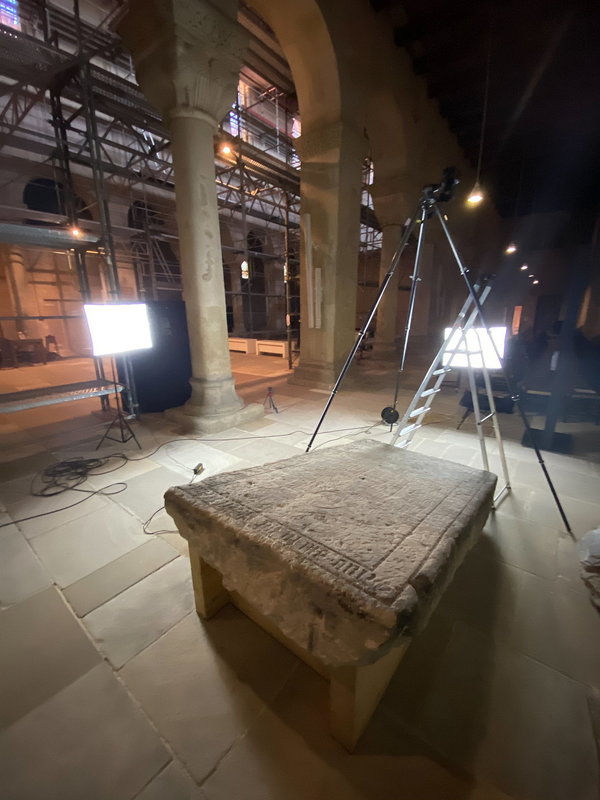
During recording work on site, the inscriptions of the collegiate church are recorded and recorded with the help of many photographs, sometimes copied. The documentation is also an important safeguard, often inscription carriers are exposed to harmful influences.
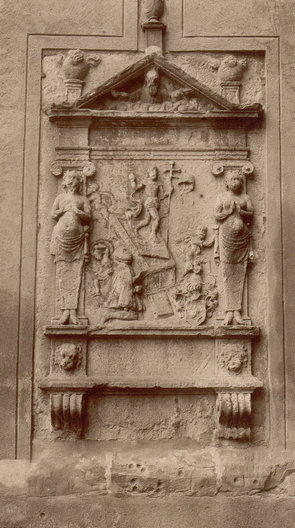
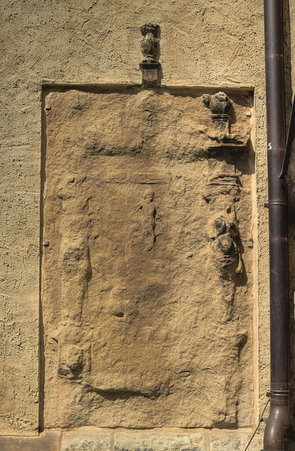
In many cases, inscriptions can be made more visible with the help of various lighting techniques. Let's look at an example:
Grave slab for Abbess Hedwig of Saxony (†1511).
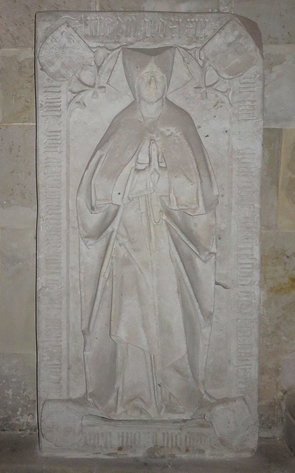
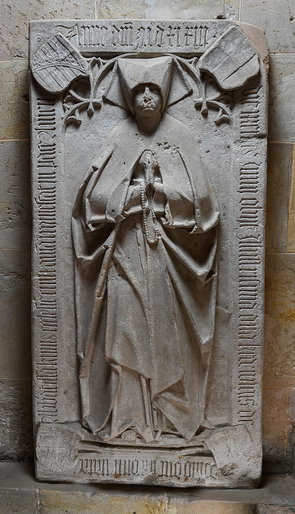
After the work on site, the inscriptions are transcribed, i.e. the writing, whether in ancient script or abbreviated carved into the stone, is entered into an inscription database in our alphabet with the help of epigraphic signs (such as brackets in the case of abbreviations that have been resolved) and translated.
In the following using the example of the grave slab for the abbess Anna von Plauen (†1458).
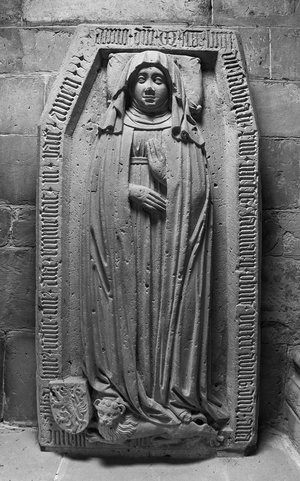
anno - d(omi)ni - M - cccc - lviii / die - sabbati - xiiii - me(n)sis - Januarii - obiit - venerabilis - d(omi)na - an(n)a / de - plawe / - abbat(issa) - hui(us) - eccl(es)ie - cui(us) - a(n)i(m)a - requiescat - in - pace - amen ---
In the year of our Lord 1458, on Saturday, 14th day of January, died the venerable Lady Anna of Plauen, abbess of this church, whose soul rest in peace, amen.
Further information on the inscription, such as dimensions, inscription bearer or dating, is added. In addition to a description of the inscription, the context of the inscription is explained in the commentary, usually information about the persons mentioned or the classification of the inscription in its historical environment. In addition to the catalog of these and the other inscriptions of the collegiate church, the other churches and the many house inscriptions of Quedlinburg, the introduction of the inscription volume also provides an overall view of the inscription inventory, the development of the script and the historical context. Ten different registers on, among other things, persons, inscription formulas, Bible verses, types of writing or offices and professions make the inscription inventory accessible.
The path from the inscription to the annotated edition is not always as "light-hearted" as in the case of Abbess Anna. On the church wall there are several pieces of stone, one of which reads: ROTHEAE SOPHIAE / THUR. MARCH. MISN. A look at the list of abbesses points to Dorothea Sophie, born Duchess of Saxony, Landgravine of Thuringia and Margravine of Meissen, who died in 1645. Here, too, an old copy helps to complete the text missing from the fragments.
It read supplemented and with abbreviations resolved:
MEMO[R]IA /
[REV]ERENDISS(IMAE) AC ILLUSTRISS(IMAE) PRINCIPIS /
[ET DO]MINAE D(OMI)N(AE) DOROTHEAE SOPHIAE /
[DUC(ISSAE) SA]XON(IAE) LAN[DGRAV(IAE)] THUR(INGIAE) MARCH(IONISSAE) MISN(IAE) /
IMP[ERATORIAE LIBERAE ABBAT]IAE QVEDLINBURG(ENSIS) [HE=/]
G[UMENAE RELIGIOSISSIMAE PARI TA]M SECULI QVAM [ET SEXUS /
SUI SUMMI ORNAMENTI N]ATA FU[IT VI]NARIAE. D(IE) XIX [DEC(EMBRIS) AN(NO) OR(IGINE MUNDI) /
MDLXXXVII SOLENNI] RITU ABB[AT(ISSA) REC]EPTA. XX. APR(ILIS) [A(NNO) MDCXVIII /
CUM VIX(IT) ANN(OS) L]VII. M(ENSEM) [I D(IES) XXIII]. PRAESED(ERIT) [A(NNOS) XXVII /
DENATA X] FE[BR(UARII) AN(NO)] MDCXLV[.]
Commemoration of the most reverend and most illustrious princess and mistress, Mrs. Dorothea Sophia, Duchess of Saxony, Countess of Thuringia and Margravine of Meissen, extremely pious abbess of the imperial free monastery of Quedlinburg, also the highest adornment of her time as well as of her sex, was born in Weimar on 19. December in the year of the creation of the world 1587, according to solemn custom received as abbess on April 20 in the year 1618, after she lived 57 years, one month (and) 23 days and presided (over this monastery) 27 years, she died on February 10 in the year 1645.
In a building and art monuments directory from 1922, this epitaph, i.e. a funerary monument that does not necessarily have to be placed in the local context of the burial place, is still described as complete with few damages. It was destroyed in the thirties, the fragments were rediscovered in 2008. By means of old photos the grave monument and the position of the texts can be described.
Wozu Inschriften?
Inscriptions are historical sources of the first rank, they increase our knowledge about the past. In many cases they give general information about people - the abbesses are also known from other sources, but often mentions in inscriptions are the only traces we have of a person. Inscriptions tell us about life dates and life paths, but also, for example, about conventions of commemorating the dead and ideas about the afterlife of their time. Inscriptions often name donors and explain their carrier on which they were placed. They report on construction measures, on natural events such as floods or destruction by fires and wars. In addition to historical studies, the inscriptions are also of interest to theology, including linguists who can use the inscriptions to study linguistic phenomena or trace the reception of the Bible and other literature in the inscriptions. The inscription carriers, whether tomb slab, sarcophagus, painting, bell, altar reredos or chalice, are always also objects of art history, often outstanding ones.
In addition to the scientific aspect, inscriptions are also in themselves exciting testimonies of the past. Often created for posterity, they fulfill a specific function: they preserve the people of the past associated with them in cultural memory. Through them, many abbesses and other persons from the environment of the monastery are still materially present in the collegiate church today.
With the planned inscription edition for the city of Quedlinburg, the inscriptions of the World Heritage Site can also be classified on a supra-regional level. So far, more than 100 towns and districts have been processed in the ten working groups of the German Academies of Sciences and Humanities and the Austrian Academy of Sciences in Vienna, and more than 70 of them are already freely accessible and searchable on the Internet in the inscription database DIO - Deutsche Inschriften Online(www.inschriften.net). Until the Quedlinburg inscriptions are posted, it is worth taking a look, for example, at the inscriptions of the neighboring city of Halberstadt(Volume 1, Cathedral and Volume 2, City) or the city of Essen with the Essener Damenstift.
